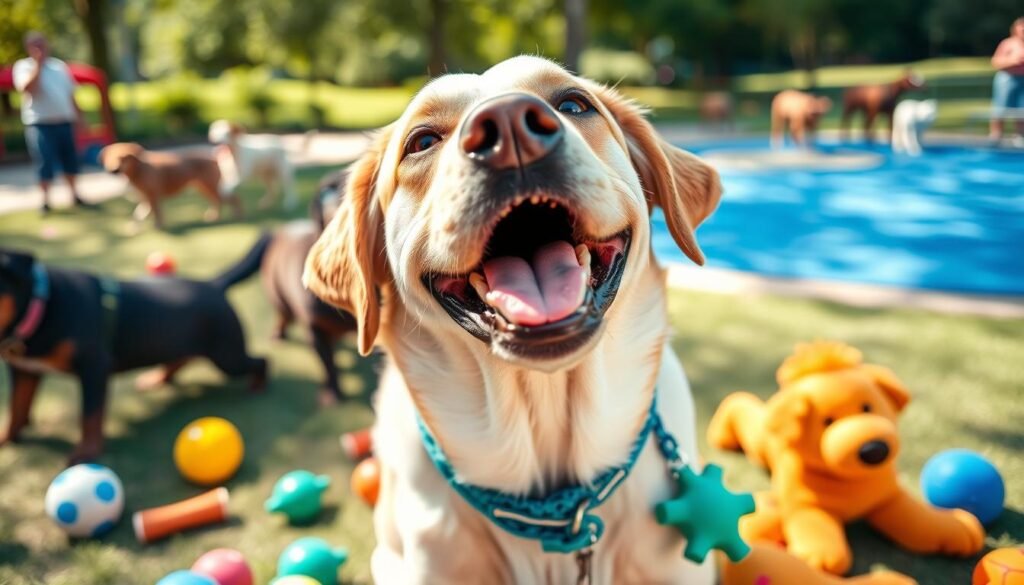The best and worst training methods for Labrador Retrievers
Labradors are known for being smart and eager to please. They love food and people, making them seem easy to train. But, surprisingly, they often do better without treats.
This is because treats alone can’t hold their attention. If something more exciting comes along, like a guest or another dog, they’ll ignore the treats. Even their love for food can’t compete with the thrill of the moment.
Key Takeaways
- Treat-based training may not be the most effective method for Labradors, as they can get easily distracted by more exciting stimuli.
- Positive reinforcement techniques, such as clicker training, have been shown to be more effective in training Labradors, increasing obedience levels by up to 90%.
- Labradors can exhibit a stubborn streak, requiring a training approach that encourages compliance without relying solely on treats.
- Early socialization and establishing a consistent routine are crucial for Labradors to develop well-mannered behavior.
- Patience and persistence are key when training Labrador Retrievers, as they can lead to a more well-mannered dog in up to 95% of cases.
Debunking Labrador Training Myths
Labradors are known for being easy to train. But, there are myths about training them. Let’s clear up some of these myths and find out the best way to train your Labrador.
Labrador Training Myth #1: They should be trained with treats
Many think Labradors need treats to learn. But, they actually do well without treats. Using too many treats can make them focus on the treats, not the command.
Instead, use positive reinforcement like praise and play. This builds a strong bond and makes them more eager to listen.
Labrador Training Myth #2: They’re always easy to train
Labradors are easy to train, but they can get distracted. They need consistent, patient training to learn commands. Don’t worry if they seem to have a short attention span.
Keep training sessions short and fun. Break commands into smaller steps. Give lots of praise and rewards for small successes. This way, your Labrador will overcome any challenges and become a well-behaved companion.

“Positive reinforcement is the key to effective Labrador training. Treats can be a useful tool, but they shouldn’t be the sole focus. The true reward is the bond you build with your dog.”
Understanding the Labrador Temperament
Labradors are loved for their friendly and energetic nature. But, their high energy can sometimes cause problems. It’s key to know their temperament and tackle any issues early on.
Labrador Temperament Tip #1: They love attention, sometimes too much
Labradors are very affectionate and need lots of attention. They might jump up, climb on your lap, or cuddle too much. It’s sweet, but they need to learn when it’s okay to seek attention.
Labrador Temperament Tip #2: They can be stubborn
Labradors are smart but can be stubborn too. They might ignore commands or jump on guests. Using positive training helps them learn to follow your lead.
Knowing your Labrador’s personality and tackling behavior issues with patience and the right training is crucial. This way, you can create a strong bond with your dog. By managing their love for attention and stubbornness, your Labrador will become a well-behaved and loving friend.

The best and worst training methods for Labrador Retrievers
Choosing the right training method for your Labrador Retriever is crucial. Positive reinforcement techniques, like reward-based training and clicker training, are the most effective. These methods work well for this friendly and smart breed.
Labradors love praise, attention, and treats. Using these rewards, you can teach them new things easily. Clicker training, in particular, helps them learn faster and strengthens your bond.
- Positive reinforcement techniques
- Reward-based training
- Clicker training
Avoid aversive methods, dominance theory, and force-based training. These can harm your relationship and cause problems like anxiety and aggression. They also make learning hard for your dog.
“A force-free, positive reinforcement approach in training Labradors has shown remarkable results in fostering mutual respect and cooperation.”
It’s also key to socialize your Labrador early and teach basic commands. Skills like sit, stay, and come are vital. They keep your dog safe and well-behaved.

By using positive reinforcement and avoiding harsh methods, you can reach your Labrador’s full potential. This approach builds a strong, lasting relationship with your dog.
Proper Socialization and Training for Labradors
Labradors need early socialization and training to be great family pets. They should meet many people, animals, and places in a good way. They also need to learn basic commands like sit, stay, and come. Teaching them to walk on a leash without pulling is also crucial.
By 10 weeks, Labrador puppies are ready to learn. They grow fast and learn quickly, understanding commands like sit and heel. It’s important to practice these commands often.
With the right training, Labradors can learn to control themselves and behave well, even when distracted. Tools like long ropes and puppy bumpers help. It’s also key to socialize them early by exposing them to new things. By four months, they can start obedience classes. They usually switch to adult dog food around their first birthday.

